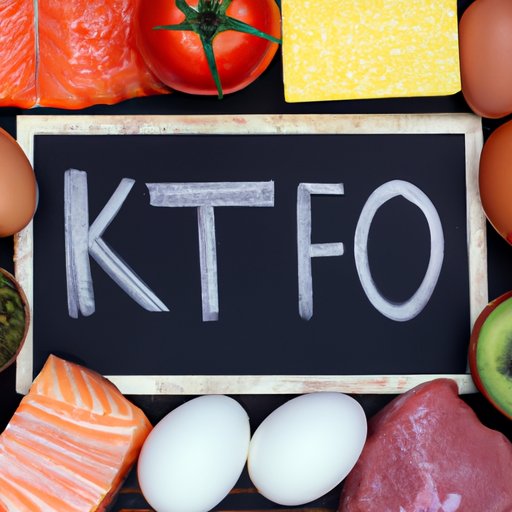
Introduction
The keto or ketogenic diet is a low-carb, high-fat diet that has gained immense popularity in recent years. This eating pattern involves reducing carbohydrate intake to a minimum and increasing the consumption of fats and proteins. The goal is to change the body’s metabolic state, forcing it to switch to using fat as the primary source of fuel through a process called ketosis.
The aim of this article is to provide a comprehensive guide to the keto diet, including its fundamentals, benefits, and potential risks. We will explore whether the keto diet is right for you, discuss meal planning and preparation, and delve into the science behind the keto craze.
Going Keto: Understanding the Fundamentals of the High-Fat, Low-Carb Diet
The basic premise of the keto diet is to force the body into a state called ketosis, which involves breaking down stored fat into molecules called ketones to use as fuel instead of glucose. To achieve this, the diet drastically reduces carbohydrate intake and increases fat intake, while also consuming moderate amounts of protein.
Foods to avoid in a keto diet include sugary foods like sweets and soda, grains like rice and pasta, and starchy vegetables like potatoes. Recommended foods include meat, fish, eggs, low-carb vegetables like leafy greens, and healthy fats like olive oil, avocado, and nuts.
One of the significant benefits of a keto diet is that it reduces hunger and cravings, leading to reduced calorie intake and ultimately, weight loss. The diet can also improve insulin sensitivity and lower blood sugar levels, making it a potential aid for people with diabetes or prediabetes.
Is the Keto Diet Right for You? A Comprehensive Guide
Before starting the keto diet, it is essential to assess whether it is the right choice for you based on your health concerns, pre-existing medical conditions, fitness goals, and weight loss objectives. It is best to consult with a healthcare provider before starting the diet, especially if you have any underlying health conditions.
Some potential risks associated with the keto diet include nutrient deficiencies, constipation, kidney stones, and an increased risk of heart disease and other chronic illnesses in the long run.
Keto 101: What You Need to Know Before Starting the Diet
A successful keto diet requires meal planning and preparation. This can involve tracking macros, planning meals in advance, and cooking meals at home to ensure you are getting the appropriate nutrients in the right amounts. Grocery shopping should also involve selecting high-quality, low-carb foods that are keto-friendly, such as meat, fish, low-carb vegetables, and healthy fats.
Cooking techniques for a keto diet may involve more frying, baking, and sautéing to use healthy fats like olive oil, butter, and coconut oil. Dining out can also be challenging, but with some careful menu selection and planning, it’s still possible to enjoy meals with friends and family while staying on track.
The Science Behind the Keto Craze: Exploring the Benefits and Risks
Ketogenic diets have been studied extensively, with many studies pointing to potential benefits, such as aiding in weight loss and improving overall health. The diet can improve insulin sensitivity and blood sugar regulation, reduce inflammation, and improve mental clarity and focus.
However, some studies also suggest that long-term adherence to a keto diet might also have negative effects, such as an increased risk of heart disease and other chronic illnesses. People with certain medical conditions may also be at risk when following the keto diet.
A Beginner’s Guide to the Keto Diet: Tips and Tricks to Get Started
Starting a keto diet can be challenging, but with some tips and tricks, it can be a sustainable lifestyle change. Meal planning advice involves finding recipes and meal plans that fit your taste preferences and macro targets, while also hydrating adequately and considering electrolyte supplements to prevent dehydration.
Some recommended recipes for beginners include keto pancakes, stir-fry, and roasted salmon with avocado salsa. Lifestyle changes may involve incorporating more physical activity, such as low-impact exercises like yoga or walking, into your daily routine.
Breaking Down the Macros: How the Keto Diet Works for Weight Loss and More
Macros, short for macronutrients, include carbohydrates, protein, and fat. In a keto diet, the goal is to eat a high-fat, moderate protein, and low-carb diet. This ratio can vary depending on individual needs, but typically entails a macronutrient ratio of approximately 75% fat, 20% protein, and 5% carbohydrates.
By restricting carbohydrates, the body is forced to rely on fat stores for fuel, leading to weight loss. Because the keto diet reduces hunger and food cravings, many people find it easier to stick to a calorie-restricted diet, leading to significant weight loss over the long term.
Conclusion
The ketogenic diet is a low-carb, high-fat diet that has gained popularity in recent years. While research suggests potential benefits for weight loss, blood sugar regulation, and overall health, it’s not suitable for everyone. Before starting the diet, it’s essential to consult with a healthcare provider and consider your health goals and medical history.
Some essential tips for getting started with the keto diet include planning and preparing meals in advance, shopping for high-quality, low-carb foods, and finding healthy cooking techniques that incorporate healthy fats. Overall, the keto diet can be a sustainable change with significant weight loss and health benefits, provided it’s done safely and when appropriate for one’s overall health.




